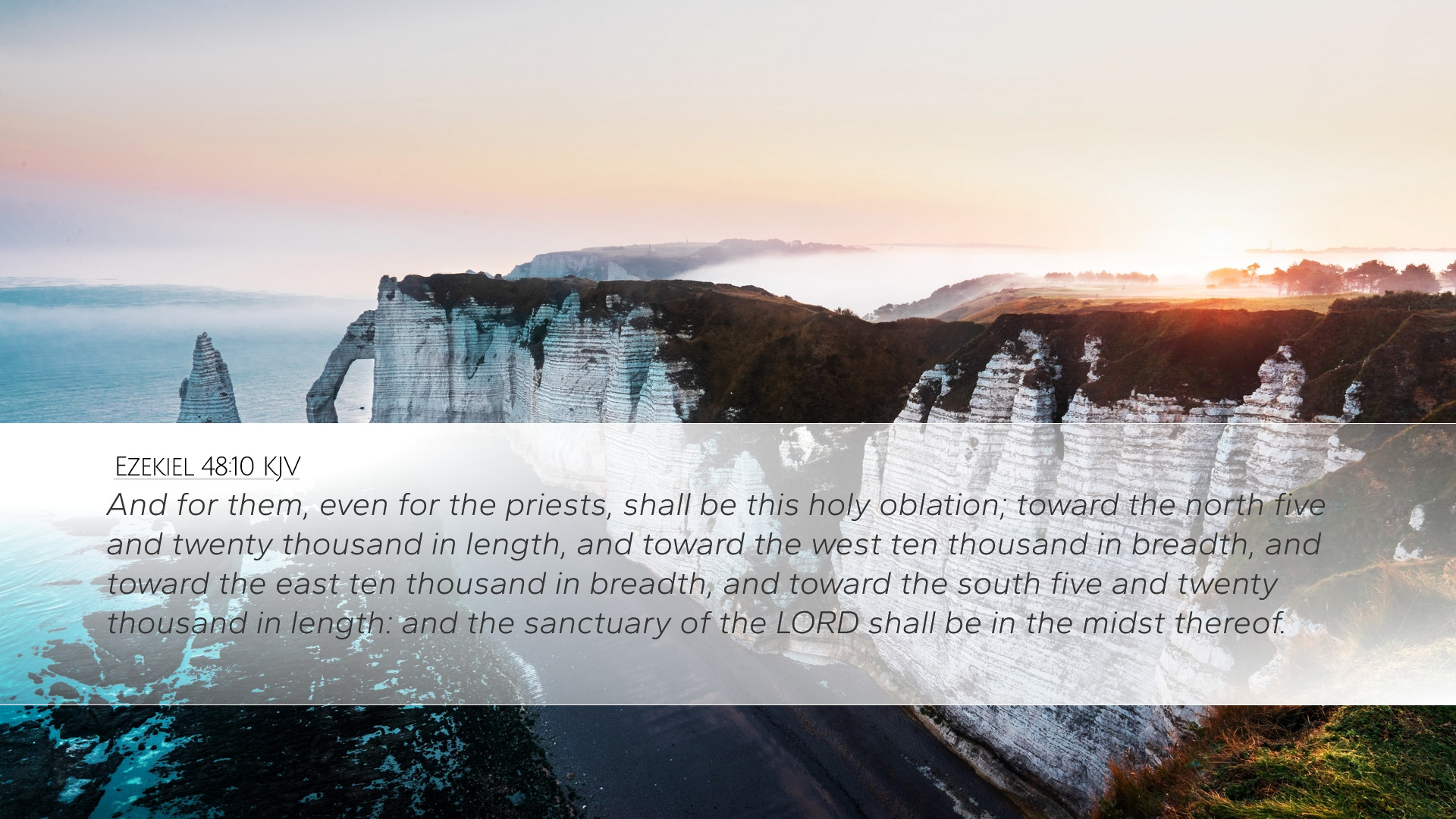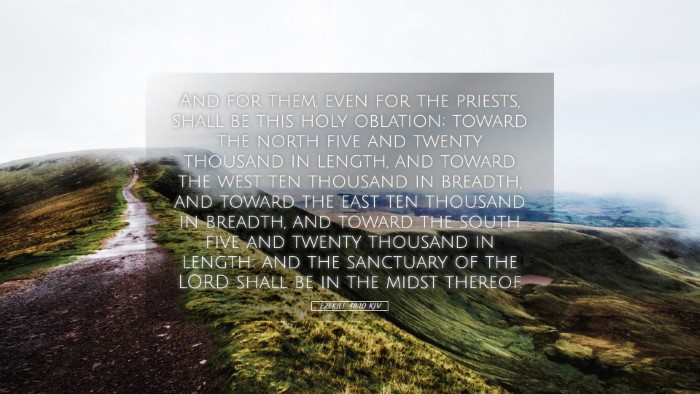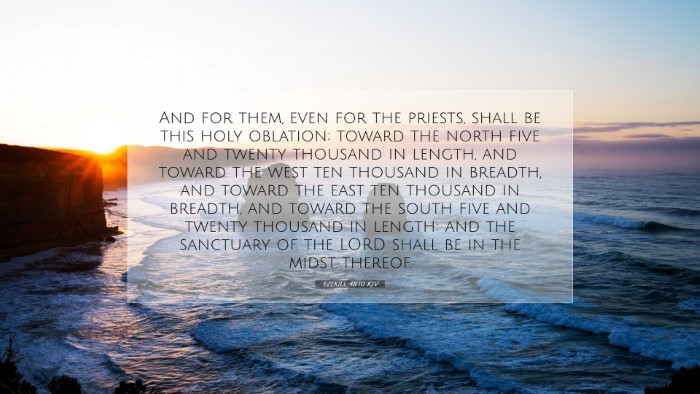Ezekiel 48:10 - A Commentary
Bible Verse: Ezekiel 48:10
"And for these, the priests shall have an area measuring twenty-five thousand cubits in length, and ten thousand in width; this shall be holy to the priests..."
Introduction
The Book of Ezekiel offers a profound vision of restoration and hope for the people of Israel. In this particular verse, Ezekiel describes the allocation of land for the priests during the establishment of a future temple and its surrounding cities. This commentary synthesizes insights from various public domain commentaries, focusing on the implications for pastoral ministry, theological understanding, and communal life.
Contextual Background
The context of Ezekiel 48:10 is crucial for understanding its significance. Ezekiel was a prophet during a time of great turmoil for Israel, following the Babylonian exile. The prophecy outlines the future of the land and the arrangements for God's people in their restored state. The descriptions within this chapter emphasize God's faithfulness to His covenant, despite the prevailing circumstances of despair.
Restoration of Israel
The allocation of land is a reflection of God's promise to restore Israel. As Matthew Henry articulates, “This division of the land signifies the division of the heavenly inheritance among saints.” The priests, as mediators between God and the people, are given a specific portion that underscores their holy calling.
The Significance of the Priestly Portion
Understanding the area designated for the priests reveals important implications for their role in worship and community life.
Divine Selection of the Priests
Albert Barnes comments on the choice of land for the priests, noting that the land's dimensions—twenty-five thousand cubits in length and ten thousand in width—reflect a divine appointment. This area is sanctified, making it a sacred space where the priests can serve God without distraction or defilement.
Holy Designation
The designation of this land as “holy” signifies its separation from the common use. Adam Clarke elucidates that this holiness is essential, for it represents God's presence among His people. The priests are set apart both spatially and spiritually, embodying the principle of holiness that is central to their ministry.
Liturgical Implications
The land allocated for the priests not only serves practical purposes but also carries deep liturgical significance. It is within this sacred space that worship will be conducted, offerings made, and intercession performed.
Roles and Responsibilities of the Priests
The responsibilities of the priests within this holy area are multifaceted. Matthew Henry notes that they must maintain the rituals of the temple worship, ensuring that the people can approach God appropriately. This divine expectation reinforces the importance of sanctity in worship.
Access to God
The allocation of a dedicated space for the priests illustrates God’s desire for His people to have access to Him. Albert Barnes highlights that the priests act as intermediaries, conveying the needs of the people before God and facilitating their relationship with Him.
The Community's Relationship with the Priests
The interaction between the priests and the community is crucial for understanding the function of this land. The priests have the responsibility not only to serve God but also to lead the people in their worship and to provide spiritual guidance.
Mutual Responsibility
Adam Clarke emphasizes that the priests, while occupying a holy space, also bear the weight of responsibility for the spiritual well-being of the community. Their holiness is intertwined with the holiness of the people they serve, creating a reciprocal relationship.
Provision for the Priests
The designated area ensures that the priests are provided for as they carry out their duties. The community’s support of the priests through their tithes and offerings is integral, as it allows the priests to fulfill their roles without distraction. It reflects a communal responsibility to honor God through their leaders.
Theological Insights
This verse also presents rich theological insights concerning God’s nature and His relationship with humanity.
The Assurance of God’s Presence
By allocating a holy area for the priests, God reassures His people of His ongoing presence among them. Matthew Henry points out that this promise of His presence is foundational for the people’s identity as God's chosen nation, delivering a powerful message of hope amidst their historical struggles.
Symbolism of the Holy Ground
The land assigned to the priests symbolizes the broader concept of holy ground in the Scripture. Albert Barnes draws parallels to other instances in biblical history where certain spaces were deemed holy due to the presence of God—this serves as a reminder of the sacredness of places of worship in modern congregational settings.
Practical Applications
The implications of Ezekiel 48:10 extend into practical considerations for modern congregations, pastors, and theological educators.
Holiness in Ministry
The call to holiness remains pertinent. Pastors and leaders are charged with cultivating holiness in their ministries, as they are set apart for God’s work. This Scripture serves as a reminder to prioritize sanctity and reverence in worship settings.
Encouraging Community Engagement
Church communities should recognize their mutual role in supporting their leaders. Just as the priests depended on the people for sustenance, the congregation must engage in generous support of their ministers. This fosters a healthy and vibrant community essential for church growth and spiritual vitality.
Conclusion
Ezekiel 48:10 challenges both individual believers and church communities to reflect upon their roles in relation to holiness, leadership, and worship. By examining the commentary insights from Matthew Henry, Albert Barnes, and Adam Clarke, contemporary readers can glean profound lessons on living in a manner that honors God. The sacredness of the priestly allocation reaffirms the importance of approaching God with reverence, ensuring that leaders inspire and shepherd their communities faithfully.


